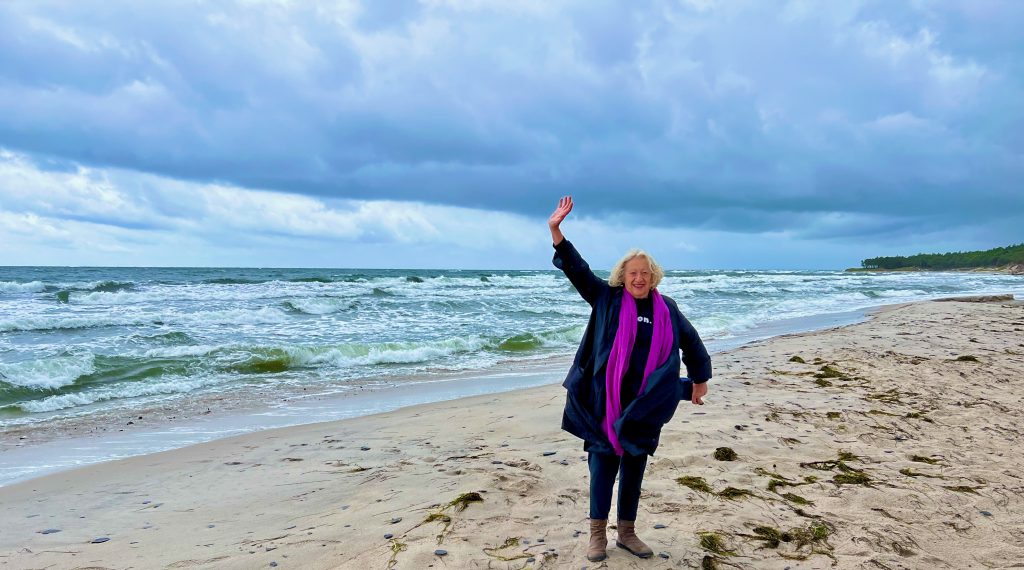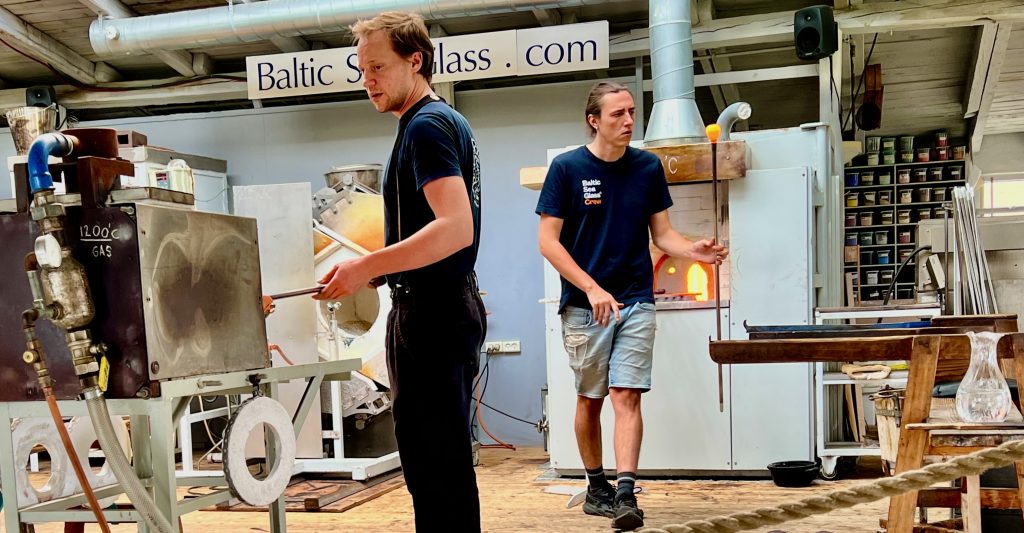




























Elaine and I flew SAS to Copenhagen on Tuesday, early in the morning. Because of a screw-up I was responsible for, however, we had to take a later flight on to the island of Bornholm. I had forgotten a speech I was meant to be doing for the AACSB, which links business schools around the world.
It turned out that I was meant to be on air at exactly the time we were meant to be in the air. Still, we made it work – and, thankfully, it seemed to go very well.
As we took off, after a holdover of something like six hours in Copenhagen Airport, Kastrup, a rainbow danced along the horizon – heralding we knew not what in terms of the week’s coming weather. As it happened, though, much of the week proved to be overcast, with some rain, though things did clear up a bit towards the end, particularly yesterday, when the sun remembered that Bornholm is meant to be the ‘Sunshine Island’.
During the short DAT flight to Bornholm, in a prop plane, we enjoyed cloud-studded but clear views of the sea, wind farms, ferries, tankers and a surfaced submarine. On arrival, Louise picked us up from the tiny airport and drove us back to the farmhouse where she and her family – in this instance Astrid, Mark and Noah – spend a significant slice of every other summer.
We clipped a pheasant along the way, though she may have been unruffled, and then turned off into a landscape of deer, hares, buzzards and, swirling around the house, swallows. Lovely to see Flossie, the Labradoodle who is a prominent feature in our Somerset House set-up, though she kept coming in from the wider world with an assortment of ticks. For a while, I became the self-appointed Tickspotter General.
Where I could squeeze it in, I continued reading Anthony Marra’s marvellous novel, Mercury Pictures Presents. I can’t remember laughing out loud so often since I read Joseph Heller’s Catch 22 at school, back in the early Sixties. Brought along a couple of other books, including Reinier de Graaf’s architect, verb, but – for whatever reason – didn’t manage to squeeze out much time for reading.
Sparked by the sight of barrows/tumuli along the roads, I dug a bit into the island’s deeper history, geological, archaeological and cultural. We then spent a goodly amount of time enjoying ourselves in smokeries, particularly the Nexø Gamli Røgeri, where the fish was extraordinary (went back several times); in restaurants, where the food was excellent; in schnapps shops like Nord in Svaneke; and in art galleries and craft workshops – including a couple of glassworks, where we watched glassblowing in real time.
Wonderful breakfasts of bread, cheeses and the like bought nearby, and then visits to special places on the island, including Østerlars, the biggest of Bornholm’s round churches, and Hammershus, a spectacularly positioned set of fortifications, albeit with a grim history extending over centuries. Learned a little about the extraordinary life of Leonora Christina Ulfeldt, who was imprisoned at Hammershus (a period during which she wrote that the rats in her cell were so ravenous that they ate her candles while they burned) and determined to read more about – and by – her.
On this, our last day, we took a glorious walk through Almindingen, the forest in the centre of the island. Not natural: instead, it was encouraged to grow from the 1800s, replacing earlier farms. An early example of rewilding. The heart of the forest, with exposed granite extrusions, trickling streams, a mixed canopy of beech and oak, and occasional lakes and reedbeds, is fabulous.
Intrigued to walk up the hill to Gamleborg, the oldest stone building on the island, and a former royal castle. This part of the visit made me think of the Japanese concept of Shinrin-yoku, or forest bathing. It seems its use as a medicinal practice only dates back to the 1980s. But we emerged from these special days feeling de-stressed and refreshed.
As we began to close the loop of our walk through Almindingen, Louise and I discussed next steps with Volans – with occasional stop-offs along the path to look at ant nests and the like. The scuttling ants put me in mind of E.O. Wilson, whose magical, short book Genesis (subtitled ‘The Deep Origin of Societies’) I had finished literally as the London-to-Copenhagen flight touched down. Had bought it three or four years ago, but never read it – until Elaine pulled it out a stack, to read herself.
The strange, endless power of serendipity.
One of the highlights of the trip, at least for me, was seeing a young girl curling up in the eye socket of a 2.5-metre replica of a human skull embedded in the floor of the Hammershus visitor centre. I missed the moment, though, when her golden hair spilled out of the eye socket like that of a latter-day Rapunzel.
That child-in-the-skull moment put me in mind of the innumerable generations of human beings, on Bornholm and elsewhere, who have helped get us where we are today. And of the responsibility we now have to ensure the interests of future generations are reinforced and well served. Future generations, that is, of all all species, not just ours.
The copy of Genesis that I read on the flight over had a cover showing birds very much like starlings, which we would see in some profusion on the island. But the U.S. edition features swooping swifts, a bird we had discussed – but not seen – as the swallows blazed in and out of their nests under the roof of the farmhouse.
Ah, the ineffable pleasures of bathing not just in forests, but in (benign forms of ) nature. This distinction between benign and less so was hammered home for me part-way through our trip to Bornholm when I stumbled again, virtually (thanks to ongoing research for my new book, Tickling Sharks), across the Smithsonian magazine’s account of the shark attacks on survivors of USS Indianapolis, back in 1945. The worst shark attack in history.
For me, all these barrows, ancient fortresses, the evidence of the German occupation and Soviet bombing of the island in WWII, and the Indianapolis story, coupled with the backbeat of news reports from places like Ukraine and Maui, Hawaii, where climate-accelerated wildfires have just killed scores of people, are a constant reminder of just how narrow the margin is between this extraordinary world we take for granted and the very different worlds that have been – and will be.
At the same time, the trip was also a useful reminder of our impending fiftieth wedding anniversary next month, my fiftieth year of professional work trying to ‘save the world’, and of my commitment to Elaine to ensure that we see a bit more of this extraordinary world while we still have both the time and inclination.



Leave a Reply